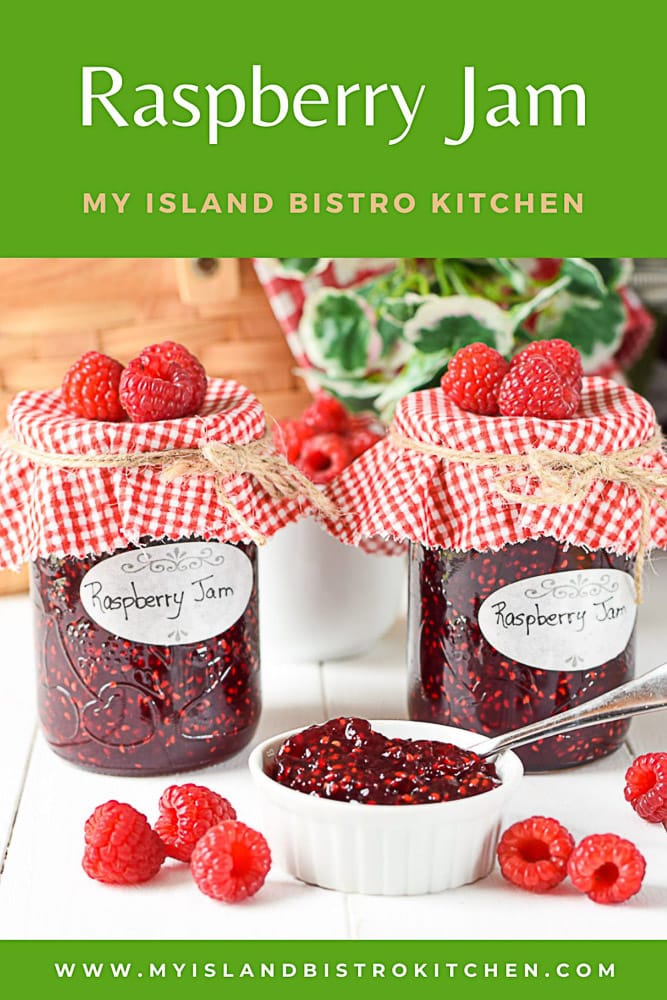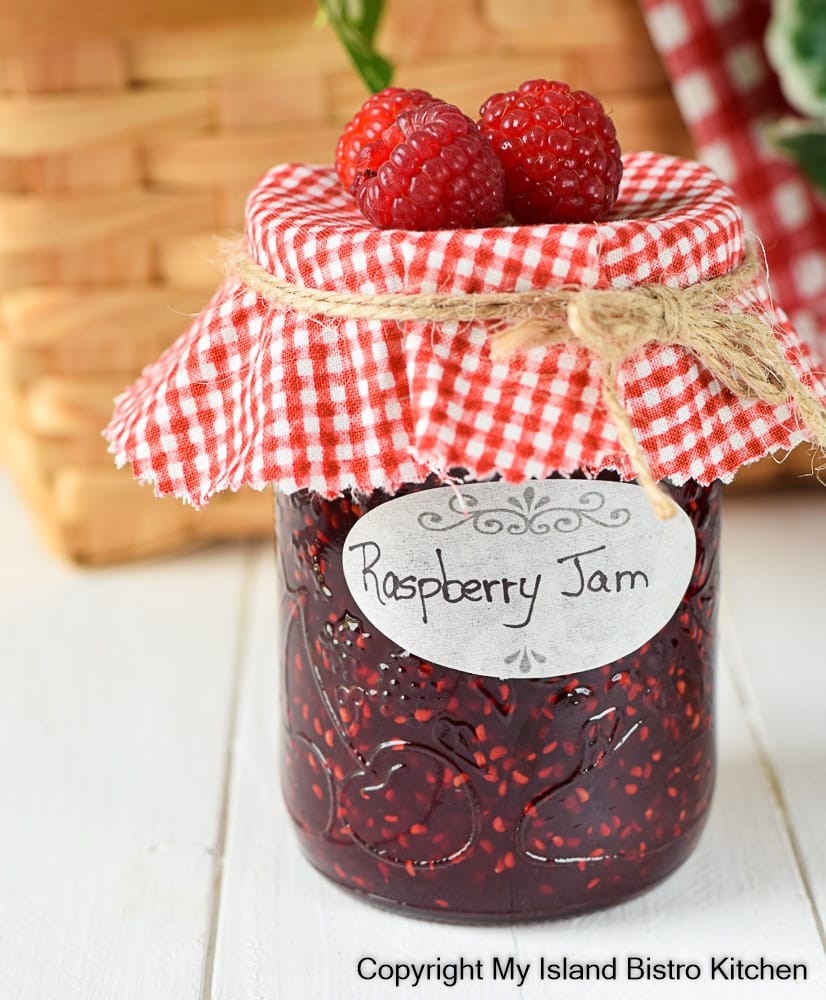
Oh, the treat of homemade Raspberry Jam! This is a traditional cooked Raspberry Jam with no pectin added. This method of jam making is sometimes referred to as “long boil jam” because it is cooked on the stovetop until the jam has cooked down and thickened.
This jam does not take a lot of ingredients but each of the ingredients does provide essential functions to the jam setting/gelling, flavor, and preservation. I recommend using fresh raspberries in this recipe versus frozen berries which typically have more moisture in them from having been frozen and this may affect the setting/gelling of the jam.
Raspberry Jam is lovely on toast, scones, biscuits, muffins, dolloped on custard, or used in filled cookies.
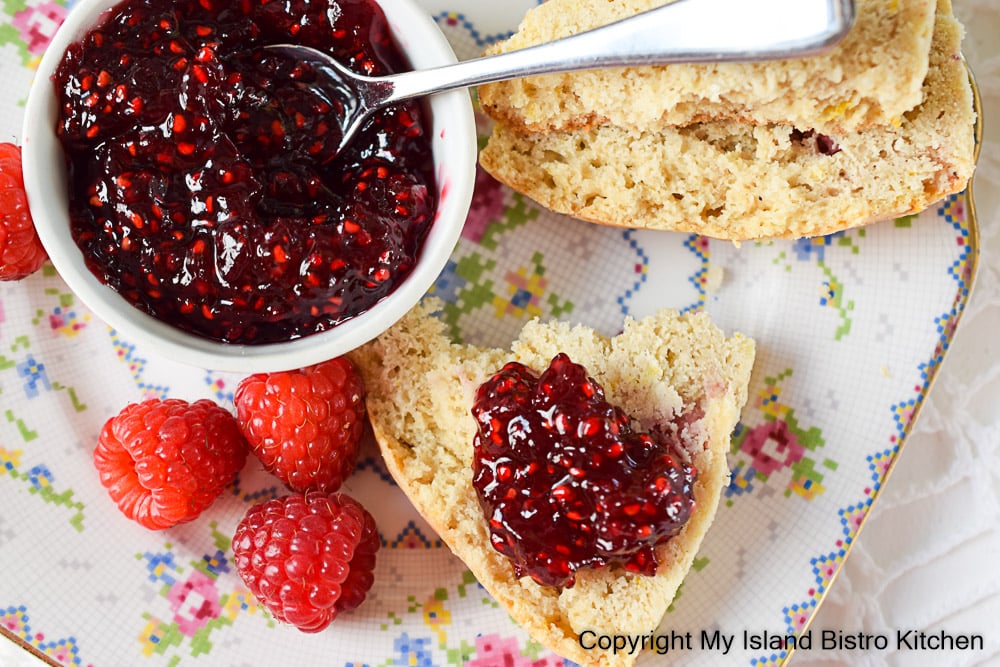
TIPS FOR SUCCESSFUL JAM MAKING
1) Prepare the Groundwork Before Beginning to Make the Jam
Read and re-read the recipe to ensure complete understanding of the process and that you have all the necessary ingredients and equipment.
Assemble all equipment and ingredients needed for the jam-making and canning processes.
2) Follow the Recipe Exactly – No Substituting, Omitting, or Reducing of Ingredients
Follow the recipe exactly, without substituting, omitting, or reducing amounts of ingredients (unless an ingredient is listed as “optional”). Each ingredient contributes something valuable to the finished product. For example, it is well-known that jam recipes call for a lot of sugar. Some will ask if they can significantly reduce the amount of sugar called for in a jam recipe and the simple answer is, no, not without potentially affecting the setting/gelling properties of the jam and sacrificing the quality and preservation/shelf stability of the jam. Apart from the sweetness sugar imparts on jam, it also acts as a preservative, protecting the jam against the development of bacteria, yeast, and mold. It is what will make the jam shelf stable for several months.
The addition of lemon juice, in most important terms, helps the natural pectin found in the fruit to gel or set properly. The acidic properties of the lemon juice also balance out the sweetness of the jam, add flavor notes, brighten the color of the jam, and help to preserve the color of the fruit in the jam. Bottled lemon juice (as opposed to freshly squeezed lemon juice) is preferred by many jam makers because its acidity level is regulated and thus consistent. This is in contrast to fresh lemons that vary in quality and ripeness.
Adding a tiny amount of butter helps to reduce the amount of foam that will naturally occur during the cooking process. It is normal for some foam to occur that will need to be skimmed off but you want the foam formation to be as little as possible as that amounts to wastage of the jam.
A pinch of salt, listed in this recipe as an optional ingredient, serves only to help bring out the flavor of the fruit in the jam. It is not enough to cause a salty tasting jam and has no impact on the preservation or shelf stability of the jam.
3) Use Only Proper Canning Jars for Jam
Use only proper canning glass jars. In Canada, the bottles are mostly sold under the brand name “Mason” and in the United States, I believe the common brand is “Ball”. Never use old used bottles that a commercial product (e.g., instant coffee, pasta sauce, etc.) has been bought in as these are not suitable canning jars. Exercise caution purchasing jars, that look like canning jars, at places like dollar and discount stores as they may not, in fact, be tempered glass suitable for canning.
Inspect the jars to ensure there are no chips or cracks in them. Wash the jars and lids in hot soapy water and rinse well.
Inspect the screw bands and discard any that have dents or rust on them. Use only brand-new lids for canning. The lids give the jars the vacuum seal and are designed for single use only. Once they have been used, the rubber sealing compound is no longer considered effective for proper sealing so the lids should never be re-used. The screw bands, on the other hand, are reusable provided they have no dents or evidence of rust.
4) Sterilizing the Jars
There are various methods for sterilizing the bottles for the jam. I use the traditional method of boiling the jars in a pot of hot water on the stove. I recommend getting this process going before getting the jam underway and the bottles will remain in the hot water after they have been boiled 10 minutes and until the jam is ready to be bottled.
5) Determining When Jam is Set/Gelled
I recommend the use of a candy thermometer for jam-making as I find, with knowing the temperature of set jam, it gives me a more accurate test of when the jam has reached the setting stage. If, however, you don’t have a thermometer, the chilling method of jam on a cold saucer (described below) may also be used to test the jam for setting stage. Jam sets from 218°F – 220°F. I typically cook my jams to 220°F but 218°F is fine and the jam will be very slightly less thick than if cooked to 220°F. While the jam should be stirred frequently as it cooks, to avoid scorching, it will require more frequent stirring as it boils down and starts to thicken.
If a candy thermometer is not available, place 2-3 freezer-safe saucers in freezer. To determine if jam is set, place a small amount of jam on chilled saucer and slightly ‘tilt and swirl’ saucer around to distribute the jam. Let jam sit, untouched, for about a minute, then gently push your finger through the jam. If the jam “wrinkles” but holds its shape (i.e., does not immediately run back together after the finger has been removed from the jam), it is set and ready to bottle. If not, continue to cook mixture, repeating the “chill” test about every 3 minutes or so (always removing the pot from the heat while conducting the chill test) until the jam passes the “chill” test.
6) Hot Water Processing of Filled Jam Jars
The jars of hot jam need to be processed in a hot water bath to ensure that any microorganisms are destroyed and the jam is shelf-stable for several months. Do not skip this step. In simplistic terms, the heat from the boiling water bath prevents the growth of mold on the jam. Fill the canner about one-half full of hot tap water and start to bring it to the boiling stage to have ready when the jam is finished and ready for its hot water bath.
As the jam is nearly at the setting stage, it’s also a good idea to get a kettle of boiling water ready in case extra is needed to top up the canner after the filled jars are added. The hot jars of jam need to immediately go into the hot water bath so, after the jam is bottled, there will be no time then to start boiling the canner water which can take a significant period of time. Jam-making really is a sequential process!
Note that I recommend adding 1 to 2 extra half-pint jars to the pot with those being sterilized for the jam. The extra bottles do not, themselves, need to be sterilized as they will only be used to fill up extra space in the canner basket so those jars filled with jam do not topple over in the hot water process. Most canner baskets will hold 6 – 7 half-pint jars and, if a batch of jam has less quantity than that, the bottles will fall over unless the basket is filled with bottles. This particular batch of jam should yield 6 pint jars but a lot depends on the quality of the berries and it is difficult to say with exact assurance the precise quantity of jam a recipe will yield. For this reason, I do recommend having 1-2 extra jars ready to fill up the canner space, if they are needed. The empty jars must be hot going into the boiling water in the canner as, otherwise, the temperature change could cause cold jars to crack when they are submerged into the boiling water. The easiest way I find to heat them is to simply put them in the pot with the jars being sterilized.
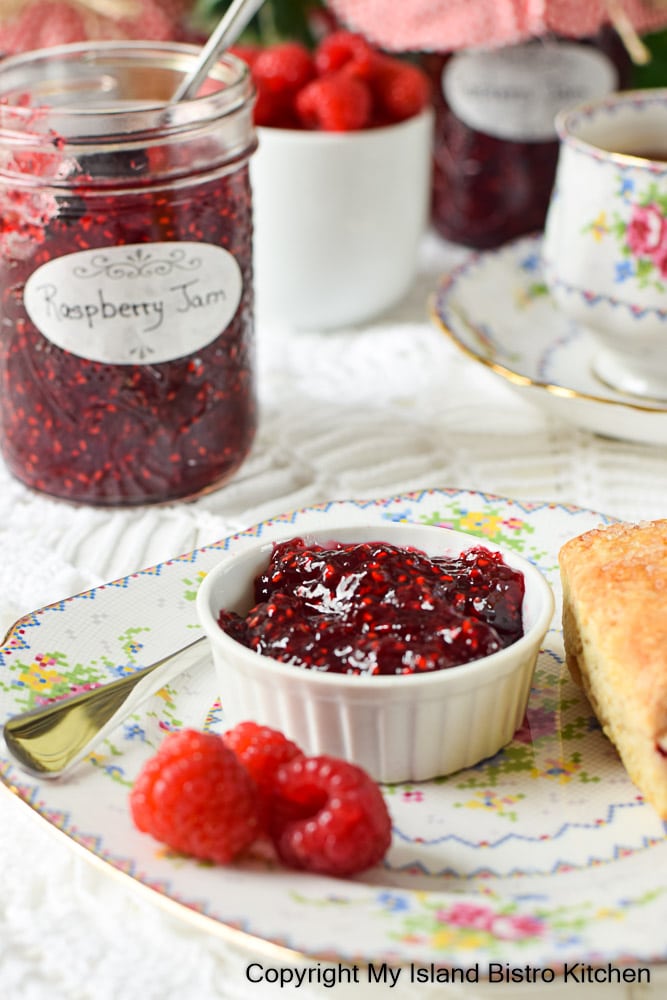
{Printable recipe follows at end of post}
Traditional Raspberry Jam (no pectin added)
Ingredients:
3 lbs fresh raspberries
2¼ lbs granulated sugar
6 tbsp bottled lemon juice
1 tsp butter
Pinch salt (optional)
Supplies and Equipment Needed:
6 half-pint glass canning jars for the jam (plus 1 – 2 more half-pint-sized jars to take up extra space in the canner basket during the hot water process)
6 – two-piece lid and screw band sets (lids must be brand new and NOT previously used)
Medium-sized, heavy-bottomed, stock pot for jam
Large-sized pot for sterilizing jars
Small saucepan for heating jar lids
Potato Masher
Large, heat-proof spoon for stirring jam
Water bath canner with basket
Jar lifter tongs
Wide-mouthed canning funnel
Ladle or heat-proof glass measuring cup
Chopstick or small non-metallic heat-proof spatula to remove any air bubbles/air pockets from filled jars
Magnetic lid lifter
A timer
Clean cloth for wiping jar rims of jam-filled jars
Method:
Place raspberries in medium-sized stock pot and use a potato masher to coarsely mash down the berries. Add the sugar and stir to mix it in with the berries. Let mixture stand for about 30 minutes to allow the sugar to dissolve and the raspberries to begin releasing their juice.
Wash jars in hot soapy water. Rinse. Fill a large-sized pot about two-thirds full of hot tap water. Place the jars, upright, into the water. Ensure the jars are fully submerged, each jar filled with water, and that the water is at least an inch over the tops of the jars, adding more if necessary. Cover, bring to a boil, and boil gently for 10 minutes. Turn off heat and leave the jars in the hot water to have ready to fill once the jam finishes cooking.
Fill the canner about half full of hot tap water. Cover and bring to a boil to have it ready for processing of the filled jars.
While the jars are sterilizing and the water in the canner is heating, begin making the jam. Add the lemon juice, butter, and salt to the raspberry-sugar mixture and bring to a boil over medium heat. Stir mixture frequently to prevent scorching. Maintain a steady gentle boil (reducing heat slightly if jam boils too rapidly), until mixture reads 220°F, on a candy thermometer (See Note 1 below for alternative testing method of jam’s setting point). Skim off and discard any foam that surfaces as the jam cooks. When jam has reached 220°F, remove stockpot from heat and, using a spoon, skim off and discard any residual foam.
Use jar lifter tongs to carefully remove the hot sterilized jars from the water, one at a time, emptying the water from the jars back into the pot. Drain jars well.
Using a ladle, or a heat-proof glass measuring cup, and a wide-mouthed canning funnel, pour jam into the hot sterilized jars, leaving about ¼” headroom in each jar to allow for expansion during the hot water processing. Remove any trapped air bubbles in the jars with a chopstick or small heatproof, non-metallic spatula. Wipe the jar rims with a clean damp cloth to remove any stickiness or jam particles that could prevent the lids from sealing properly to the jars.
Remove a small amount of the hot water from the stockpot in which the jars were sterilized and place in small saucepan over simmering heat. Place the lids in the hot water to soften the rubber sealing compound. Do not boil the lids.
Using a magnetic lid lifter, remove lids from the hot water and center the heated lids on jars so the sealing compound on the lid edges aligns with the jar rims. Fingertip tighten ring/screw bands on jars until resistance is encountered. Do not over-tighten.
Using jar lifter tongs, carefully place filled jars upright in wire basket positioned in the canner, ensuring jars do not touch each other or fall over. Depending on the canner basket shape and design, it may be necessary to add one or more of the hot empty jars, upright, to the basket to fill up space so the filled jars do not topple over. Let the empty jars fill with water from the canner as they are submerged. Ensure the water level is at least 1” above the tops of jars, adding more boiling water as necessary. Cover with canner lid. Increase the heat to return the water to a full rolling boil then decrease the heat to just keep the water at a moderately rolling boil but not boiling over. Process jars in the hot water bath for 10 minutes, adjusting time as and if necessary for altitude. Start timing the processing from the point at which a full rolling boil is reached after jars have been added to the canner. At the end of the processing time, turn off heat and remove canner lid.
Let jars sit in the hot water for 5 minutes then, using jar lifter tongs, carefully remove the jars filled with jam, one at a time, and transfer them to a heat-proof cutting board, that has been covered with a towel, to cool completely. Listen for the “pop” or “ping” sound as the bottles seal over the next few minutes or hours. The lids of properly sealed jars will curve downward. Let jars rest, undisturbed, on counter for 24 hours. Then, test each jar for proper sealing by lightly pressing down on the center of each jar lid. If the lid is already pressed downward, and does not pop back up, it is properly sealed. Any jars that do not pass this test should be refrigerated and the jam used within a week or so. Store properly sealed jam bottles in cool, dark place. Refrigerate jam once jar has been opened.
Yield: Apx. 6 half-pint bottles
NOTE 1: If a candy thermometer is not available, place 2-3 freezer-safe saucers in freezer. To determine if jam is set, place a small amount of jam on chilled saucer and slightly ‘tilt and swirl’ saucer around to distribute the jam. Let jam sit, untouched, for about a minute, then gently push your finger through the jam. If the jam holds its shape (i.e., does not immediately run back together after the finger has been removed from the jam), it is set and ready to bottle. If not, continue to cook mixture, repeating the “chill” test about every 3 minutes or so (always removing the pot from the heat while conducting the chill test) until the jam passes the “chill” test.
If you have made this recipe and enjoyed it and/or wish to share it with your friends and family, please do so on social media but be sure to share the direct link to this posting from my website.
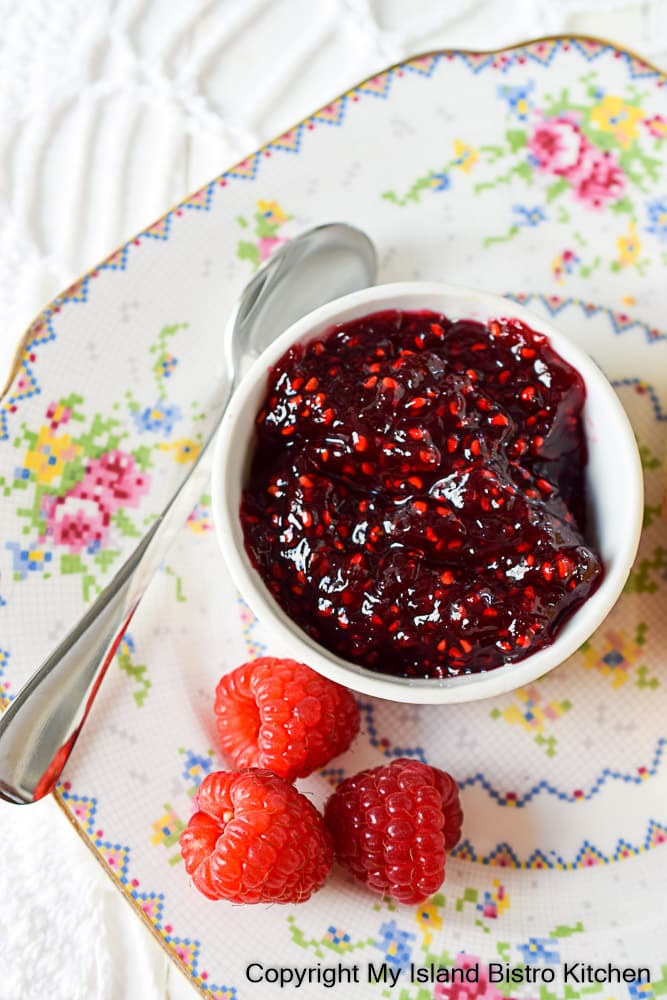
You may also enjoy these other tasty jam, marmalade, and jelly recipes from My Island Bistro Kitchen:
Jams
Small Batch Cherry Jam
Strawberry-Rhubarb Freezer Jam
Blueberry and Grand Marnier Jam
Gooseberry Jam
Zucchini Jam
Pumpkin Jam
Marmalades
Rhubarb Marmalade
Green Tomato Marmalade
Peach Marmalade
Jelly
Strawberry-Rhubarb Jelly
Rosy Rhubarb Jelly
Crabapple Jelly
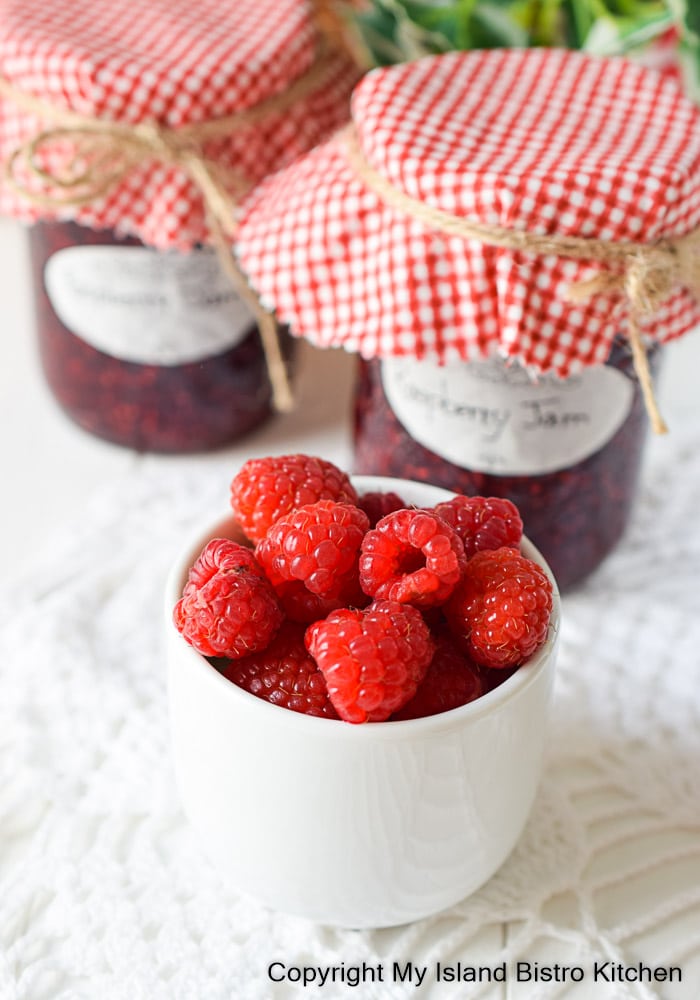
Connect with My Island Bistro Kitchen on Social Media
Join the Facebook page for My Island Bistro Kitchen: https://www.facebook.com/MyIslandBistroKitchen/
Follow “the Bistro” on Twitter: https://twitter.com/PEIBistro/
See the drool-worthy gallery of mouth-watering food photos from My Island Bistro Kitchen on Instagram: https://www.instagram.com/peibistro/
Follow “the Bistro” on Pinterest at https://www.pinterest.ca/peibistro/ and pin the Pinterest-ready photo at the end of this posting to your favorite Pinterest boards!
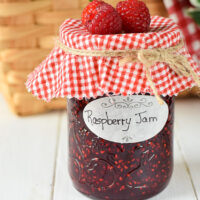
Traditional Raspberry Jam (no pectin added)
Ingredients
- 3 lbs fresh raspberries
- 2¼ lbs granulated sugar
- 6 tbsp bottled lemon juice
- 1 tsp butter
- Pinch salt (optional)
Instructions
- Place raspberries in medium-sized stock pot and use a potato masher to coarsely mash down the berries. Add the sugar and stir to mix it in with the berries. Let mixture stand for about 30 minutes to allow the sugar to dissolve and the raspberries to begin releasing their juice.
Wash jars in hot soapy water. Rinse. Fill a large-sized pot about two-thirds full of hot tap water. Place the jars, upright, into the water. Ensure the jars are fully submerged, each jar filled with water, and that the water is at least an inch over the tops of the jars, adding more if necessary. Cover, bring to a boil, and boil gently for 10 minutes. Turn off heat and leave the jars in the hot water to have ready to fill once the jam finishes cooking.
- Fill the canner about half full of hot tap water. Cover and bring to a boil to have it ready for processing of the filled jars.
- While the jars are sterilizing and the water in the canner is heating, begin making the jam. Add the lemon juice, butter, and salt to the raspberry-sugar mixture and bring to a boil over medium heat. Stir mixture frequently to prevent scorching. Maintain a steady gentle boil (reducing heat slightly if jam boils too rapidly), until mixture reads 220°F, on a candy thermometer (See Note 1 below for alternative testing method of jam’s setting point). Skim off and discard any foam that surfaces as the jam cooks. When jam has reached 220°F, remove stockpot from heat and, using a spoon, skim off and discard any residual foam.
- Use jar lifter tongs to carefully remove the hot sterilized jars from the water, one at a time, emptying the water from the jars back into the pot. Drain jars well.
- Using a ladle, or a heat-proof glass measuring cup, and a wide-mouthed canning funnel, pour jam into the hot sterilized jars, leaving about ¼” headroom in each jar to allow for expansion during the hot water processing. Remove any trapped air bubbles in the jars with a chopstick or small heatproof, non-metallic spatula. Wipe the jar rims with a clean damp cloth to remove any stickiness or jam particles that could prevent the lids from sealing properly to the jars.
- Remove a small amount of the hot water from the stockpot in which the jars were sterilized and place in small saucepan over simmering heat. Place the lids in the hot water to soften the rubber sealing compound. Do not boil the lids.
- Using a magnetic lid lifter, remove lids from the hot water and center the heated lids on jars so the sealing compound on the lid edges aligns with the jar rims. Fingertip tighten ring/screw bands on jars until resistance is encountered. Do not over-tighten.
- Using jar lifter tongs, carefully place filled jars upright in wire basket positioned in the canner, ensuring jars do not touch each other or fall over. Depending on the canner basket shape and design, it may be necessary to add one or more of the hot empty jars, upright, to the basket to fill up space so the filled jars do not topple over. Let the empty jars fill with water from the canner as they are submerged. Ensure the water level is at least 1” above the tops of jars, adding more boiling water as necessary. Cover with canner lid. Increase the heat to return the water to a full rolling boil then decrease the heat to just keep the water at a moderately rolling boil but not boiling over. Process jars in the hot water bath for 10 minutes, adjusting time as and if necessary for altitude. Start timing the processing from the point at which a full rolling boil is reached after jars have been added to the canner. At the end of the processing time, turn off heat and remove canner lid.
- Let jars sit in the hot water for 5 minutes then, using jar lifter tongs, carefully remove the jars filled with jam, one at a time, and transfer them to a heat-proof cutting board, that has been covered with a towel, to cool completely. Listen for the “pop” or “ping” sound as the bottles seal over the next few minutes or hours. The lids of properly sealed jars will curve downward. Let jars rest, undisturbed, on counter for 24 hours. Then, test each jar for proper sealing by lightly pressing down on the center of each jar lid. If the lid is already pressed downward, and does not pop back up, it is properly sealed. Any jars that do not pass this test should be refrigerated and the jam used within a week or so. Store properly sealed jam bottles in cool, dark place. Refrigerate jam once jar has been opened.
Recipe Notes
Yield: Apx. 6 half-pint bottles
NOTE 1: If a candy thermometer is not available, place 2-3 freezer-safe saucers in freezer. To determine if jam is set, place a small amount of jam on chilled saucer and slightly ‘tilt and swirl’ saucer around to distribute the jam. Let jam sit, untouched, for about a minute, then gently push your finger through the jam. If the jam holds its shape (i.e., does not immediately run back together after the finger has been removed from the jam), it is set and ready to bottle. If not, continue to cook mixture, repeating the “chill” test about every 3 minutes or so (always removing the pot from the heat while conducting the chill test) until the jam passes the “chill” test.
Copyright My Island Bistro Kitchen 2023
PIN ME TO PINTEREST FOR LATER!
